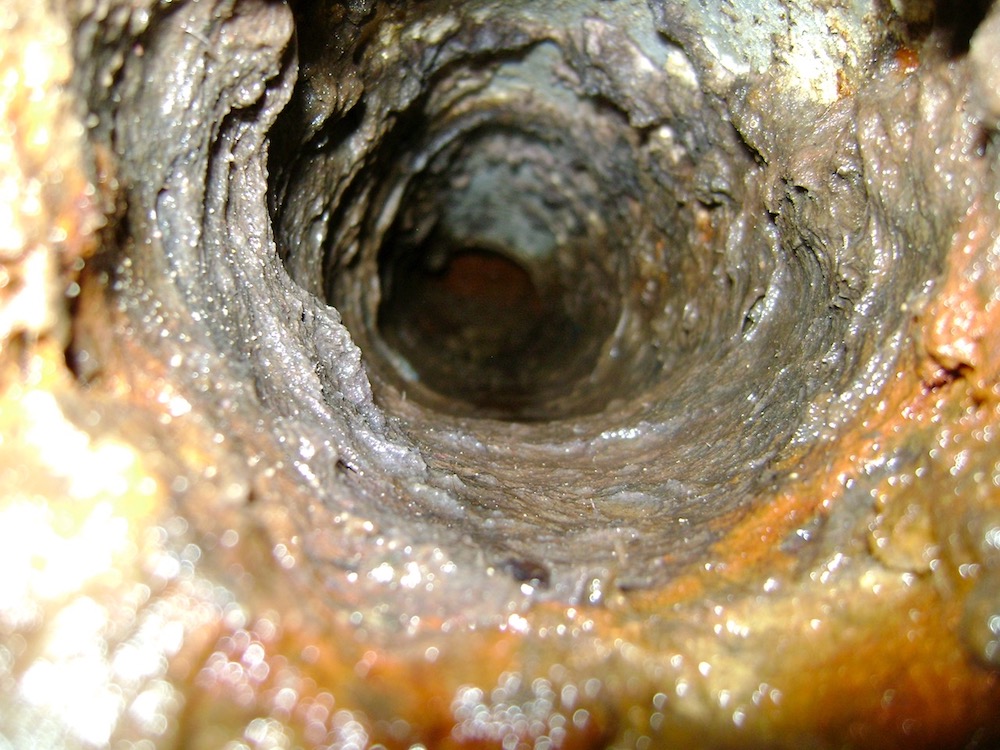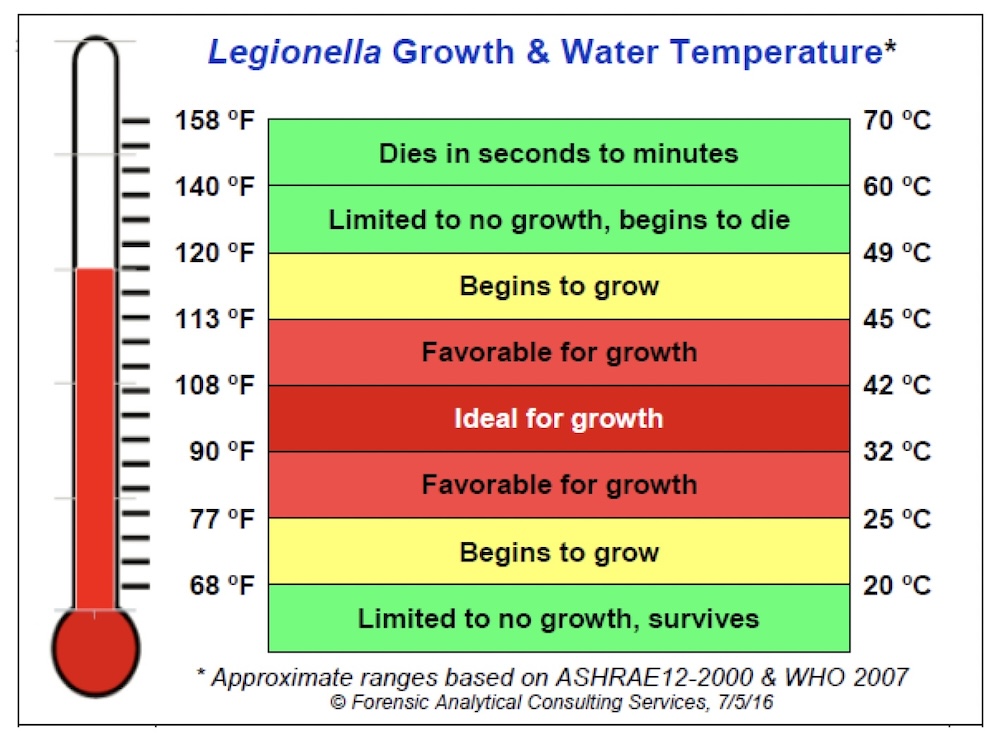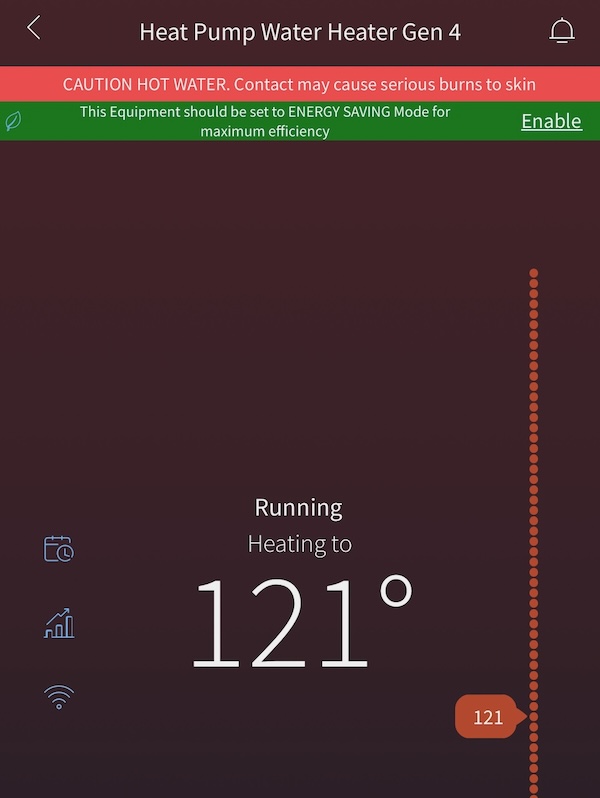
Whenever I post a photo of the control panel of my heat pump water heater (like the one above), I usually hear from at least one reader who has concerns about Legionnaires’ disease. I care about my health, so I’ve dug into this topic a little bit and have made a decision about whether to keep my water heater set at 120 °F or set it higher. I’m no expert here, though, so please let me know what you think in the comments below.
Legionnaires’ disease basics
We know a whole lot about Legionnaires’ disease now that wasn’t known in 1976 when 221 attendees at the American Legion convention came down with a mysterious illness. Thirty-four of them died, setting off a furious search for the reason. The culprit turned out to be bacteria that hadn’t been known about before. Its name came from the circumstances of its discovery: Legionella pneumophila.
Legionella grows in fresh water at temperatures between 68 °F and 120 °F. It can be part of biofilms, the slimy stuff growing in a lot wet places (like the inside of a dryer vent in the photo below). You can find biofilms with Legionella in cooling towers, shower heads, misters, humidifiers, and ornamental water features. The biofilm and its Legionella population itself isn’t the problem, though.

The way a person gets Legionnaires’ disease is by inhaling aerosolized bits of Legionella. The lungs then get infected and cause symptoms similar to those of pneumonia. Since it’s a bacterial infection, doctors treat it with antibiotics.
You can find more information on Legionnaires’ disease at the Center for Disease Control, among other reputable sources. ASHRAE has a standard, a guideline, and articles on this topic, too.
Water temperature and Legionella growth
Back to the topic of this post. First, let’s look at how temperature affects the growth of Legionella. The table below is from a presentation by John Springston at the 2018 Building Science Summer Camp.

Clearly, you want to stay away from water heater settings between 77 °F and 113 °F, the red regions in that chart. And the yellow regions, too. Above 120 °F, though, there’s not much growth and even some die-off of Legionella. So what’s a person to do?
My current position
I still have my water heater set to 120 °F. According to what I’ve read about ASHRAE’s recommendation, they say the hot water in your tank should be 140 °F or higher and that your plumbing system should deliver hot water at 124 °F or higher. ASHRAE mostly deals with commercial and institutional buildings, though, so does this apply only to those larger buildings? Or to homes, too?
I’m storing it at 120 °F and delivering it at an even lower temperature. Am I doing the wrong thing? I’m eager to learn more from health experts and will set it higher if necessary.
From what I’ve read, it seems that domestic hot water isn’t where most cases of Legionnaires’ disease come from. It’s chillers and hot tubs and water features that aerosolize Legionella particles.
And there’s another reason I feel it’s not such a big a risk in my hot water system: water heater manufacturers recommend setting the temperature to 120 °F.

Lawyers are good at finding liability, yet manufacturers don’t warn you about Legionella with that setting. They do, however, warn you about the risk of scalding if you set it higher. The screenshot above shows what happens when I go even a measly one degree above 120 °F.
That’s certainly not a guarantee of a risk-free decision. It just means the risk is too small for lawyers to have changed the behavior of manufacturers . . . or that they haven’t found the connection yet. In general, though, the number of Legionnaires’ cases is pretty small.
What temperature is your water heater set at?
________________________________________________________________________
Allison A. Bailes III, PhD is a speaker, writer, building science consultant, and the founder of Energy Vanguard in Decatur, Georgia. He has a doctorate in physics and is the author of a bestselling book on building science. He also writes the Energy Vanguard Blog. For more updates, you can subscribe to Energy Vanguard’s weekly newsletter and follow him on LinkedIn. Photos courtesy of author.
Weekly Newsletter
Get building science and energy efficiency advice, plus special offers, in your inbox.















16 Comments
The hot water tank/buffer tank is set to 140F — the thermostatic valve for DHW is set to 120F, the heat exchanger for the in floor radiant heat is set to 75F to 95F; the baseboard in the basement runs at 130F. In contrast the hot tub is set to 98F; cooking steak in the sous vide is at 125F.
Maybe the question should be where do you control the DHW temperature? At the fixture or whole house/supply side?
Allison,
I know there have been cases of Legionella in institutional settings linked to 120F water not maintaining enough heat in the distribution lines to keep them safe, but an interesting question would be whether there are any situations where that has occurred in single residential situations? I haven't heard of any.
Funny related story:
Some years ago the house next to the waterfront resort I did work for sold. A couple of months later the new owner, knowing we had 25 hot tubs, asked me if I could come over and troubleshoot his. When I opened the lid it had about three inches of horrible looking foam on the top. I asked how much chemicals he was using and he replied "What chemicals?". I asked how his skin was and he opened his shirt to show a healthy tan from his shoulders up, and alarmingly bright red skin below that. Lucky man.
In Ontario, the code requirement is a mixing valve on top to keep the tank at 140 to kill Legionella and mix it down to 120 to eliminate scalding. I looked into this for an article and found that the US DoE says
"And while there is a very slight risk of promoting legionellae bacteria when hot water tanks are maintained at 120F, this level is still considered safe for the majority of the population. If you have a suppressed immune system or chronic respiratory disease, you may consider keeping your hot water tank at 140F. However, this high temperature significantly increases the risk of scalding. To minimize this risk, you can install mixing valves or other temperature-regulating devices on any taps used for washing or bathing. "
Given what you have been through, I wonder if it is worth the risk.
Can you please share the reference for this? Thanks
https://www.buildingcode.online/2133.html
There is absolutely no attempt at enforcement, encouragement or even awareness of this code requirement. Being a resident there, I would guess that the compliance rate is about 1% or lower. All the water heaters sold here default to 49C, and have the same scalding warning mentioned in the article. I find it interesting that the requirement sets a minimum of 60C, when that is the absolute maximum of any storage water heater I've seen.
Even weirder, this requirement only applies to electric water heaters. I don't know if this was an oversight, or they have some reason that a gas water heater is exempt.
Unless you have a gas powered water heater, then you can set it at whatever you want.
arcticenergy,
https://www.ontario.ca/laws/regulation/r04023
thanks for looking into this issue. My new 66 gal HPWH is set at 120, per the mfr and installer recommendations. The installer said we could bump up the temp to adjust for line losses.
I looked into getting a mixing valve in case we added rooms, but it added $900 or more to the cost.
Our hot water at the tap seems a little cooler than before, but I don't run the recirc pump often because we rarely have hi demand for HW. I may bump up the temp setting a little to reduce the legionnella risk.
Another question: for vacations and vacation homes when the HPWH is shut down: what is the legionnella risk then? Do we need to flush the lines or super heat the system when we return?
I've wondered about the vacation home scenario, too. If the tank falls to 68F between uses, it looks little to no additional growth, but the existing bacteria won't die. My in-laws have turned off the water heater between occupancy with an electric tank set to 120F for 45 years without any known issue...
My HPWH tank is set to 130F and a mixing valve delivers it at 120F. The dishwasher and humidifier are plumbed pre-mixing-valve with home runs to ensure the quickest delivery of the hottest water. I'm not super concerned about Legionella, though do have a space constraint for the tank, making a 50-gal the best choice. The thermostatic mixing valve gives me a hedge in high usage scenarios (the old NG tank was also 50-gal). If my utility ever offers a compelling TOU rate, I could also heat the tank off-peak without worrying about scalding.
Yes, it has to be aerosolized before it can infect you. But also, before that, it requires stagnant water to populate sufficiently to be a hazard--and THAT is why it's not a hazard in residential applications. No cooling towers, for instance ;-)
DHW configurations vary and so does the risk. Given most homeowners aren't equipped to assess the risk, shouldn't the general guidance be to use higher tank temperatures with a mix-down valve? Yes, running a HPHW heater at a higher temperature will increase stand-by losses and decrease COP, but it's going to make only a small difference on the monthly utility bill. There are higher ROI efficiency choices to make than this one.
My DHW setup is one where higher tank temperatures should be the recommended practice. My A2W heat pump pre-conditions my DHW via a desuperheater. The water temp in the 50gal desuperheater tank varies depending on the cooling/heating demand of the home and could sit for lengthy periods in the Goldilocks temperature range for Legionella. So the in-series, second "finishing tank" is at 145F (can't actually changes this on the Sanco I have), to ensure delivered water is safe.
DHW recirc systems are also a potential site for Legionella. There's conflicting guidance on the risk in residential homes and what to do about it. For our system, I decided to install a Caleffi 116 thermostatic valve at the furthest point of the loop, near the point of use, so that very little hot-water is delivered to the return line. The recirc system is also triggered by an occupancy sensor and only runs for 1 minute. This hopefully keeps water temps in the return line low enough to make bacteria growth unlikely.
scsiguy,
I agree that the default standard should be a safe one, but would be interested in seeing some figures showing whether the theoretical risk of maintaining 120F in domestic systems actually ever manifests itself in Legionella cases.
Studies about bacteria in our water system have shown that shower heads and faucets have healthy colonies of really nasty bugs (in fact in water systems that are chlorinated the chlorine kills off the good, aka non-harmful bugs, and promotes the active growth of the not good ones. These bugs are found in shower heads and faucets where no one runs water temperatures above 108-110. So even if you keep your tank at 140 you are going to temper it to below 110 to wash and bathe so what's the point of keeping the tank that hot?
Please cite your references to the studies. I think everyone citing a study should provide links to it.
I'm unaware of chlorine being selective in killing certain bacteria and not other bacteria. Bacteria, AFAIK, do not develop resistance to chlorine. I will consider the possibility that perhaps certain bacteria need more chlorine for eradication that others but I'd like to see the studies.
Thanks
“[Deleted]”
Log in or create an account to post a comment.
Sign up Log in